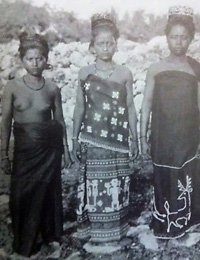| Notes: | East Sumba is famous for its warp ikat Hinggi but less well known for its supplementary warp pahikung textiles. Woven on back tension looms, complex supplementary warp techniques are used to create a rich portfolio of geometric and zoomorphic designs. In the past, pahikung were used to add decorative panels to lau tube skirts (sarongs) worn solely by the female nobility but today there is no restrictions on their use. However, because of their difficulty to weave, lau pahikung remain expensive and the prerogative of only the few. The patterns used in pahikung are not reproduced from memory but from a patterned guide known as a pahudu, hence these cloths are often referred to as Lau Pahudu.
This Lau Pahikung weaving in fine hand spun cotton is a particular fine example and was probably made to adorn two sarongs (it appears sectioned down the middle). Its principal iconography, outlined in none dyed white cotton, includes ancestor figures (ana tawu), presenting raised palms and with pronounced genitals, interspaced with symbolic trees of life. A zoomorhic panel along the top most probably depicts palm civet cats. The cloth is coloured using natural red (kombu) and indigo dyes, but has also been enhanced by brush dying of red and indigo tints onto many of the cloths pictorial elements, for example the white of the fingers, testicles and toes of the ancestor figures. .
For a similar example see:

Three women from East Sumba dressed for a funeral feast at Watumbaka, to the east of Waingapu, in 1932. Centre: a noble dressed in a ceremonial lau pahikung hiamba; Left: a bare-breasted slave dressed in a plain mud-dyed lau pakapihak; Right: a commoner dressed in a beaded lau hada (Koninklijk Instituut voor de Tropen) |




